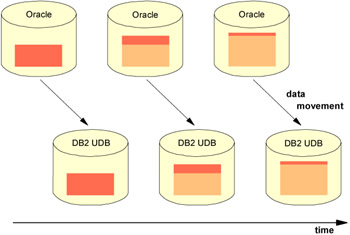6.2 Time planning
|
| < Day Day Up > |
|
6.2 Time planning
After testing the data movement and choosing the proper tool and strategy, you have to create a detailed time plan with following tasks:
-
Depending on the data movement method:
-
Implementing or modifying scripts for data unload and load
-
Learning the use of the chosen data movement tools
-
-
Data unload from Oracle
-
Data load to DB2 UDB
-
Backup target database
-
Test loaded data on completeness and consistency
-
Switch of applications including database interfaces
-
Fallback process in case of incidents
The most sensitive environment is a production system with a 7x24 hours availability requirement. Figure 6-1 shows you the way how to move the data to the target database in a high availability environment. The dark color represents the new data, the light color represents the converted and moved data. If possible, export the data from a standby database or mirror database to minimize the impact on the production environment. You have to do following tasks:
-
Create scripts that export all data up to a defined timestamp.
-
Create scripts that export changed data since the last export. This includes new data as well as deleted data.
-
Repeat step 2 as often as when all data is moved to the target database.
-
Define fallback strategy and prepare fallback scripts.

Figure 6-1: Data movement strategy in a high availability environment
When the data is completely moved to the target database, you can switch the application and database. Prepare a well defined rollout process for the applications, and the belonging interfaces to DB2 UDB. Allow time for unplanned incidents.
|
| < Day Day Up > |
|